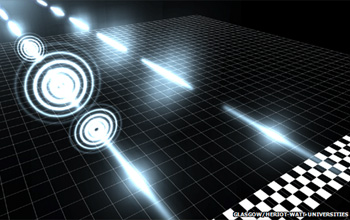
[Image: University of Glasgow]
From Einstein’s special relativity on down, the invariance of the speed of light free space has been a central tenet of physics. Now, in a clever set of experiments, scientists in the United Kingdom have demonstrated that, in certain conditions, individual photons in free space can be slowed down to speeds measurably below the supposedly invariant light speed (Science, doi: 10.1126/science.aaa3035). While the results pose no threat to special relativity, they highlight interesting properties of structured beams and, in the view of the researchers, could be applicable to other sources of wave energy, such as sound.
Slowdowns of light in nonlinear or structured materials are well established experimentally. The team of U.K. researchers (from the University of Glasgow and Heriot-Watt University) wanted to see if such an effect was also possible in free space, through changes to the transverse structure of the light beam itself.
In their experiments, they looked in particular at the so-called group velocity of light—the speed with which the modulation envelope of the beam travels through space—and focused their inquiry on the behavior of individual photons, which have been previously shown to travel at the group velocity. The scientists set up a light source that emitted pairs of photons simultaneously, and sent the matched pairs to a highly sensitive photon counter. One photon was unaltered; the other passed through several spatial light modulators that imparted a change to the beam’s transverse structure.
The researchers then simply compared the arrival times of the photons in two beams over the same propagation distance in free space, a setup analogous to a photon footrace. In that race, the scientists found that the spatially structured photons traveling through free space over a one-meter distance reached the detector several micrometers behind photons in the unaltered beam. That’s a lag on the order of 10 to 20 wavelengths—equivalent to a tiny but measurable speed drop of around 0.001%.
The team saw the same effect in both Bessel beams and focused Gaussian beams. And the fact that the delay was greater than the optical wavelength showed that it was not due to the Gouy phase shift, a known half-wavelength delay effect seen in focused Gaussian beams.
The results focused on tweaking the transverse component of light waves, and on measurements of the difference in propagation speeds of individual photons. They thus don’t seem to affect the invariance of the speed of plane light waves in free space that’s central to special relativity. Still, the authors conclude that the effect—which they say can be derived from a simple geometrical argument—should “have applications to any wave theory, including sound waves.”
